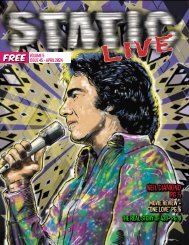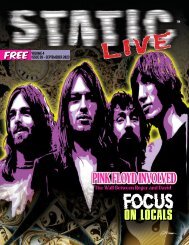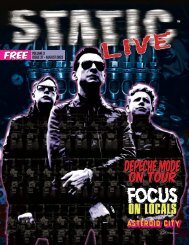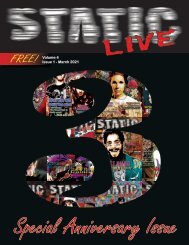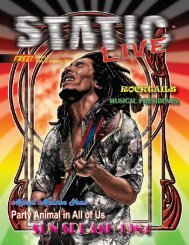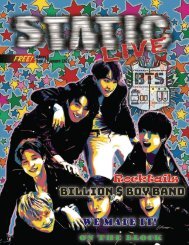Static LIVE November 2023
Static Live is for all that love the music industry and those dedicated to the future unique musical messages waiting to be heard!
Static Live is for all that love the music industry and those dedicated to the future unique musical messages waiting to be heard!
Create successful ePaper yourself
Turn your PDF publications into a flip-book with our unique Google optimized e-Paper software.
BY RELUCTANT GENIUS<br />
I’m guessing that most of us have gone to a movie theater once or twice in our lifetime, some of us weekly, or maybe even more. It is a<br />
part of our culture and an amazing part of our history. In the past, going to a theater was one of just a few ways to see a lm.<br />
Nowadays, you can watch movies on your phone, computer, smart TV or home theater projection systems. The art of going out to see a<br />
show isn’t quite the same.<br />
My rst memory of watching a movie was at the local drive-in. My parents had a brown cargo van and my sister and I had a little area<br />
to sleep in the back. We ate popcorn and sweeties and watched a couple of cartoons they<br />
showed before the feature. After being told to settle down and go to bed at least six times due to<br />
my hyperactive self I nally laid my head in the pillow and my parents settled in to the movie.<br />
Little did they know that I was lurking in the dark, waiting to catch a glimpse of the magic of the<br />
silver screen. Believe it or not I still have memories from my rst experience at the drive in. The<br />
mono speaker in the window blares and I slowly pop my head up high enough to watch one of<br />
the nal scenes of Easy Rider. While I didn’t understand the violence as the two protagonists<br />
were shot down in cold blood, I still had sad emotions and watched my parents share theirs. It<br />
was then and there I was hooked on watching movies.<br />
Today in the United States there are around 300 active drive-in theaters. Last month my<br />
girlfriend and I went to one in Buena Vista Colorado called “The Comanche” and there was no<br />
doubt that as soon as we pulled into the venue, glorious and wonderful memories of going to<br />
drive-in ooded into my brain and I felt at ease. Ultimately, though, there was also a sadness.<br />
The parking lot wasn’t entirely full, and I realized I was witnessing a dying breed.<br />
The staff was amazing. The Whoppers, Raisinets, and the popcorn were perfect. But I wasn’t<br />
happy for some reason and I’m not sure why. My guess is that I was thinking of a time when<br />
there will be no more drive-ins and the number of people that may never get to experience<br />
what I was experiencing that very night. There’s no doubt that this art form is fading away<br />
and it’s sad. Here’s a brief history of one of America’s last surviving ways of watching art.<br />
The history of drive-in theaters in the United States dates back to the early 20th century. The rst drive-in theater, called Park-In Theaters,<br />
was opened in Camden, New Jersey in 1933 by Richard Hollingshead. It featured a large outdoor screen and a parking lot where<br />
moviegoers could park their cars and watch movies from the comfort of their vehicles.<br />
The concept of drive-in theaters quickly gained popularity, especially during the 1950s and 1960s. At their peak, there were over 4,000<br />
drive-in theaters across the country. These outdoor cinemas became a symbol of American culture, offering a unique movie-going<br />
experience for families and couples.<br />
Drive-ins were known for their large screens, playgrounds for children, and concession stands that served classic movie snacks like<br />
popcorn and soda. They provided a sense of community, as families and friends would gather together to enjoy a movie under the stars.<br />
However, with the advent of home entertainment systems, multiplex cinemas, and changing consumer habits, the popularity of drive-in<br />
theaters began to decline. Many drive-ins were forced to close down or convert their spaces for other purposes.<br />
Despite their decline, drive-in theaters still hold a special place in the hearts of many Americans. They represent a nostalgic era of<br />
American cinema and continue to attract a loyal fan base. Some drive-ins have even managed to adapt to the changing times by<br />
embracing new technologies and diversifying their offerings.<br />
While the number of drive-in theaters in the United States has signicantly decreased over the years, their impact on American culture<br />
and the movie industry remains signicant. They will always be remembered as a unique and cherished part of the country's<br />
entertainment history.<br />
Here’s hoping future generations will get to experience what past generations did when it comes to watching movies at the drive-in.<br />
The history is amazing, and should be studied even more, because without them many of our ancestors never would’ve gotten their rst<br />
kiss, or maybe even to second base or falling in love gotten married who knows for at one point the drive-in was essentially the most<br />
popular place in town to meet and hang out. Those days are long gone but who knows - nostalgia seems to be coming back so maybe<br />
one day the drive in will be popular again.<br />
the<br />
PAGE 15





